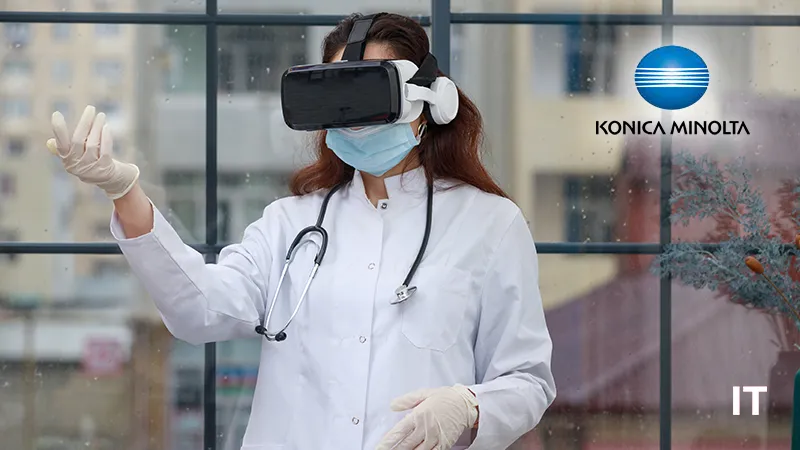Konica Minolta Healthcare Americas, Inc. announced several new digital radiography (DR) solutions designed to help streamline radiology workflows and efficiently manage imaging department assets and resources. These solutions will be introduced at the 2024 Radiological Society of North America (RSNA) Scientific Assembly and Annual Meeting, being held December 1-4 in Chicago, IL. The company is also proud to announce four papers on Dynamic Digital Radiography (DDR) as part of the RSNA 2024 Scientific Program.
Konica Minolta is introducing Bone Suppression Imaging (BSI) for chest X-rays. The recently FDA-cleared BSI suppresses the ribs and the clavicle to enable clearer visualization of the lung, enhancing diagnostic clarity and efficiency. BSI will be available as a stand-alone solution with Konica Minolta DR systems and Exa® PACS.
The AeroDR PDR is the newest addition to the AeroDR® family of wireless flat panel detectors. This 14 x 17-inch value-based panel combines the advanced technology and design improvements from Konica Minolta’s current glass-based and glassless models while also addressing the needs of budget-constrained and cost-conscious customers. AeroDR PDR is designed for the retrofit market to help facilities upgrade existing systems and modernize their technology.
“Konica Minolta builds on the quality, durability and reliability of the AeroDR family of detectors and image processing software with these new solutions that provide clinical and economic value to our customers,” says Lisette Carrara, Senior Marketing Manager, Radiology, Konica Minolta.
Also Read: HealthTap Enters DME Market, Partners with Aeroflow
Data Analytics/Service Solutions
Konica Minolta will launch the next generation of AeroRemote® Insights, a comprehensive analytics solution that collects and aggregates DR system health and usage data into dashboards to help radiology department and imaging center administrators best manage DR assets and personnel. AeroRemote Insights 4.0 represents a significant leap forward in innovation and user experience with a platform that is substantially faster and simpler to navigate. A new AI-powered chatbot swiftly curates the required data and answers user questions for quicker and more efficient support. Also new are a Superuser profile that provides greater control and customization, including changing operator, workstation and facility names, as well as a global data filtration tool that provides selectors over all pages of the dashboard.
Konica Minolta dealers now have access to their own Dealer Dashboard, providing the ability for dealers to manage their customer system status, streamline system management and identify revenue opportunities for their customer sites that are using AeroRemote Insights. All user and dealer dashboards are fully HIPAA compliant, contain no personal health information and adhere to the highest security standards.
“With AeroRemote Insights 4.0, we are empowering healthcare providers and dealers with an unparalleled tool that enhances efficiency, supports informed decision making and ultimately improves patient care,” said Robert Kenley, Vice President of Commercial Services at Konica Minolta Healthcare Americas. “We are proud to bring this cutting-edge solution to the forefront of medical imaging technology.”
DDR Studies at RSNA 2024
Konica Minolta is proud to announce that for the fourth consecutive year, clinical studies featuring DDR are part of the RSNA 2024 Scientific Program.
Michaela Cellina, MD, Head of Imaging Research and radiologist with ASST Fatebenefratelli Sacco in Milan, Italy, will present two posters:
- Chest Bedside Applications of Portable Dynamic Digital Radiography (DDR): Bringing the Dynamic Acquisition to the Patient’s Bed (CHEE-113). This poster, part of the Chest Imaging Education Exhibits (CHEE), discusses the use of DDR to evaluate diaphragmatic dysfunction in patients at the bedside, including post-surgery. In the ICU, DDR can provide lung ventilation data to help identify regional differences and assess the effectiveness of different respiratory treatments. DDR was found to be useful in diagnosing breathing abnormalities in lung cancer patients and pulmonary perfusion abnormalities related to chronic and acute conditions.
- Dynamic Digital Radiography: A Novel Imaging Technique to Investigate Patients with Cervical Pain (M5A-SPNR-16). As part of the Neuroradiology Poster Discussions on Monday, December 2, Dr. Cellina will discuss the results of a prospective study of 20 patients evaluated for long-term cervical pain who had poor response conservative treatments. Each patient previously had an MRI and underwent cervical DDR that included consecutive movement of the cervical spine (C-spine) flexion and extension. The study found that C-spine imaging with DDR “allows an optimal evaluation of spondylarthrosis and adds functional information about the range of movement excursion and about the presence of stiff discs.”
In a poster co-authored by Yuzo Yamasaki, MD, PhD, Assistant Professor at Kyushu University, DDR will be highlighted as a functional lung imaging technology, including perfusion and ventilation, in an Educational Exhibit, Finding Pneumo: Advanced Pulmonary Functional Imaging Methods (CHEE-119). The exhibit is a multi-institutional collaboration that describes the pros and cons of several imaging techniques. Mauricio Stanzione Galizia, MD, Clinical Associate Professor, Radiology, Division of Cardiothroacic Radiology, University of Michigan Medicine, Ann Arbor, MI, will present the data.
Source: Konica Minolta

































